–The Rooftop Cylinder
Date of alleged incident: 22 January 2018
Report Date: 9 July 2018
Introduction
Following on from my first study into the alleged chlorine attacks in Douma in 2018 I am now going to cover the alleged 22 January attack. The original plan was to work through the events in dated order, as would make the most sense, but as I began to gather the evidence I allowed it to direct the order of importance.
This investigation can be split into two sections. The main evidence presented as proof of the attack is a modified IRAM 107mm munition on the rooftop of a building. This was also the cylinder that Eliot Higgins of Bellingcat geolocated. The other evidence is sporadic and unremarkable and doesn’t lend any support to the claim of the attack occurring. I may well draft a smaller report on that evidence for completion purposes but for now, the focus is on the main cylinder.
As is quite often the case in such chemical attack claims in Syria, Eliot Higgins acts as a hub for the dissemination of the story and its evidence. I don’t think I am being unfair to him to suggest he controls the narratives of these claims to the western audience. Therefore this investigation, much like its predecessor, focuses quite a lot on Eliot and his reports.
In a situation like this, when you are investigating the claims of one person you run the risk of being accused of singling that person out for unfair attention. This is not a blog I have decided to start to go after Eliot or anyone else. I follow the evidence and allow it to take me wherever it should please. Given that all claims of chlorine rockets in Syria lead a path back to Eliot (a quick Google search will attest to this) it is only natural that his claims would be central to any chlorine weapon investigation.
The Claim
As with the alleged 1 February 2018 attack it is claimed this attack took place around 05:30 Damascus Time. It is alleged that “9 rockets loaded with gas” were fired on the area of Douma close to ‘The Farms’ (you will recall this being the area from the alleged 01/02/18 attack).
That claim was made by a Twitter account under the name of @Azm_Lens that is no longer operational but thanks to “WayBack” I was able to pull some archived tweets. Again the claims of causality figures are an issue with variance depending on the source, which I will get to.

He also tweets in Arabic only this time introduces, what I aptly call, “the rooftop cylinder”, to the world.

When the text in the tweet is translated it becomes…

For the purpose of completeness, I will add that he/she also posts another tweet of another munition that I will include in any follow up to this report. However, I will add that the same munition was alleged to have been used in the 1 February attack too so providing it here doesn’t lend anything to the rooftop munition investigation.
CIT, or the Conflict Intelligence Team, defers to “local media” and quotes an “Adnan Shami” who also claims “9 rockets” were fired.
Rami Adbel Rahman of the UK based SOHR (Syrian Observatory for Human Rights) was quoted as saying:
Residents and medical sources talk of chlorine gas,
But went on to say this couldn’t be confirmed.
VDC or The Violations Documentations Center in Syria interviewed a Doctor Adnan Yassin from the same hospital as Dr Oyoun (below) who said:
I cannot confirm that the targeting was with chlorine gas. But as I mentioned earlier, all of the injured had the same smell on their clothing as a result of the missile targeting. This is what I can confirm
Interesting to note at this stage that both the pro-opposition SOHR and an alleged doctor both said they cannot confirm the attack was a chlorine attack.
Casualties
As with the alleged 1 February attack, medical staff claimed to have begun receiving patients at exactly 05:45. According to a joint Bellingcat/STJ report a Doctor Mohammed Oyoun from the “Damascus Countryside Speciality Hospital” said:
The hospitals received 21 suffocation cases, including 8 men, 6 women and 7 children, with a child who is less than three months.
Mohammed Katub of SAMS claims;
4 women, 7 children and 10 men were contaminated this morning in #Douma eastern #Ghouta by a toxic gas bomb. Symptoms indicative to chlorine. This is attack # 3 in 2018 and # 193 since 2012 in Syria.
— Mohamad Katoub (@MhdKatoub) January 22, 2018
More silence will mean more attacks
Reuters quoted both the SOHR and White Helmets as claiming 13 people had suffered suffocation.
Yet the White Helmets Twitter account claims “More than 20 [cases] of suffocation so far”.
More than 20 of suffocation so far following the bombing of the Assad regime forces with missiles carrying poisonous gases (probably chlorine) on the residential neighborhoods in #Douma #Eastern_Ghouta #GhoutaIsBleeding pic.twitter.com/Ier1FIjR43
— The White Helmets (@SyriaCivilDef) January 22, 2018
Julian Röpcke of the German Tabloid BILD claims 22 civilians, “most of them children, suffered from intoxication”.
#News
— Julian Röpcke (@JulianRoepcke) January 22, 2018
22 civilians, most of them children, suffered from intoxication after another #Assad regime #ChemicalWeapons (Chlorine gas) attack on #EastGhouta.
The gas was delivered in nine Katyusha rockets.#Syria pic.twitter.com/shUnZrKFXq
Unlike the SAMS doctor who claimed 10 men, 4 women and 7 children were injured, the aforementioned Mohammed Oyoun of the Damascus “Specialist Hospital” claimed 8 men, 6 women and 7 children as victims as per Bellingcat.
“The hospitals received 21 suffocation cases, including 8 men, 6 women and 7 children, with a child who is less than three months.
I could go on but I assume you get the idea. The breakdown of the age-sex structure differs upon who is being asked. We saw the same issue with the previous February study and this, by itself, alerts one to the credibility of the information being reported and those reporting it, I would add.
The Bellingcat Chemical Connection
One of the tenets of my previous study into the 1 February incident was the questionability over the evidence being presented to support the official narrative.
This report works on the same ethos and again I point to, what I believe to be, very questionable evidence being presented to support a rather flimsy official narrative.
Previously I pointed out how Eliot Higgins’ conclusions on impact craters and the trajectories of the alleged rockets defied basic laws of physics. I questioned why, given his adamance on transparency, he didn’t offer workings on how he reached the conclusions he did on the trajectory, distances and azimuths. This part of the investigation continues along that same theme of prodding at evidence offered by Eliot that contains glaring inconsistencies. Whilst researching this incident I came across several instances of what, at best, I could call sloppiness, at worst, I could call deceitfulness, in Eliot’s investigations into alleged chemical attacks in Syria. Let me give you one example of what I am referring to and you decide if you think it was sloppiness or something more.
In a 23 January 2018 article on Bellingcat, Eliot writes about alleged chemical attacks. He supplies the image below with the caption: “The remains of a chlorine cylinder used in an attack in March 2017.”
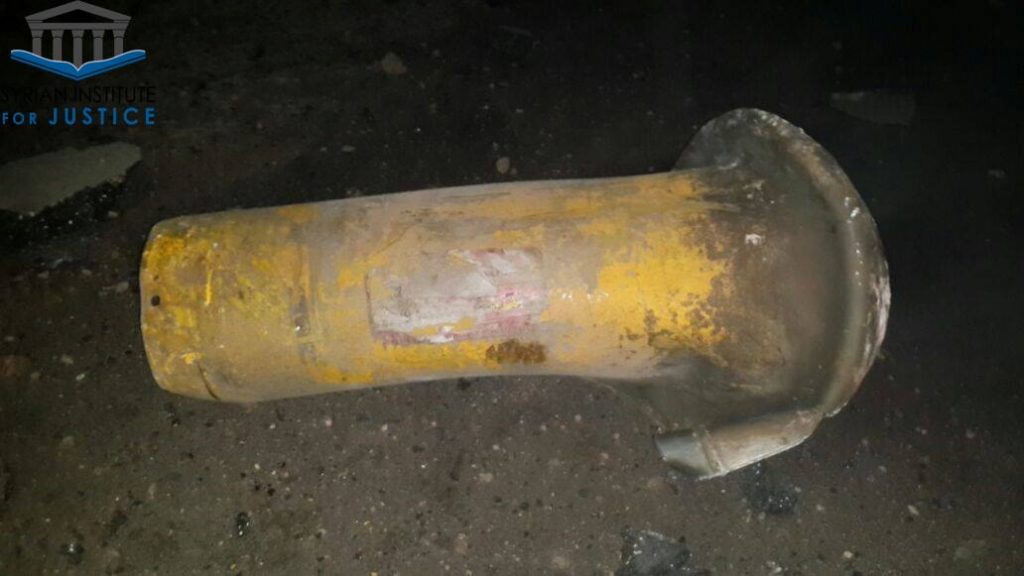
Yet if we look into the archives on Bellingcat we come across a 2016 article by Christiaan Triebert entitled “The CL2 Before the Storm — Alleged Chemical Attacks in Aleppo in the Last Months of 2016” in which we see the exact same image being used in connection with an alleged chlorine attack in Aleppo in 2016.
I wanted to include this example to show a lack of due diligence being applied to Eliot’s investigations into these alleged chlorine attacks. I believe such examples are extremely relevant in establishing credibility and trustworthiness. But what if it was a one-off? If it was it would still be concerning, given the context, but accidents happen. As this investigation progresses you will see that there are quite a few examples of due diligence not being applied and evidence being accepted with a certain degree of bias by Eliot.
The Higgins Geolocation
Bellingcats’ partner in this report, STJ (Syrians for Truth and Justice), interviewed an “activist” from Douma named Jamal al-Hasan who was, it is alleged, “the first one to reach the impact site”. He told STJ that a rocket had fallen on a house (emphasis mine). Eliot assumes the rocket in the image below is that which Jamal is referring to. This lead Eliot to try and geolocate its position.
Jamal al-Hasan, an activist from Douma who was the first one to reach the impact site, told STJ that one of the rockets loaded with poisonous gases was found embedded in the dirt, and 15 m from its strike location, another rocket was found fallen on a house. The rocket described as found fallen on a house may refer to one rocket it was possible to geolocate, featured in several photographs:
Emphasis mine.

As a starting point for his geolocation he used the claims of “an armed Syrian opposition member” under the alias “Mohammed Al-Shami” who was allegedly interviewed by STJ and who allegedly said;
“The north-west area within the stadium located in Douma, along with al-Manfoush neighbourhood had been targeted with 9 rockets loaded with poisonous gases. Sound of the rocket launch and the way it fell indicated that it was a Katyusha rocket, which was a Russian-made propellant charge that the regime had modified by supplying it with a homemade cylinder and the head was fitted with homemade detonators, leaking poisonous gas immediately after hitting the ground. It should be mentioned that five rockets had fallen directly on residential areas, whereas the four left had fallen in the agricultural areas adjacent to Douma.”
Mohammed Al-Shami (alias) Syrian fighter.
It is being reported that a Syrian fighter claimed the munitions used were “Katyusha rockets” whilst the photo evidence suggests they were modified3 IRAMs. This fighter goes on to allege the rockets were fitted with “homemade detonators” which of course they weren’t. There are no detonators on these alleged chlorine cylinders as, if they indeed contain chlorine, they rely on impact to fracture the payload body or to break off the valve on top of the cylinder for chlorine to escape. That’s the working theory of most observers and leads to a lot of hypothesising as the design doesn’t make a lot of sense. That’s a topic for another post though.
Eliot doesn’t address the alleged witness testimony, either to support or debunk it, instead, he moves on to geolocation.
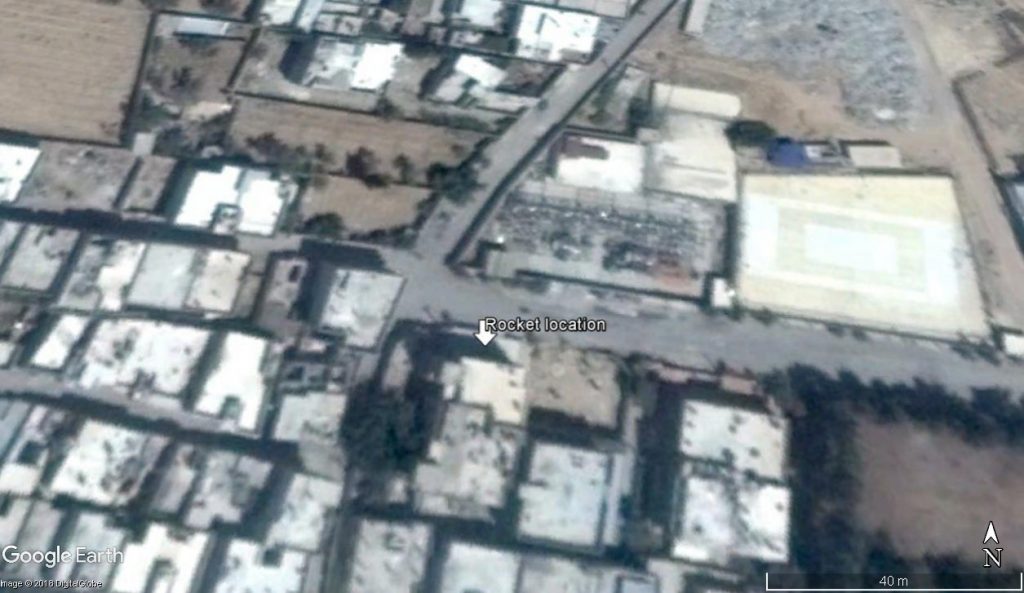
So from the above picture and the words of Al-Shami, Eliot geolocated the rocket’s position to here:
Eliot says;
The location the photograph on the roof was taken is 33.572149, 36.387439, on the roof a one storey structure running west to east on the north side of a larger apartment building. In addition to the geolocation of the photographs, the location was also confirmed by locals who took photographs of the munition.
It is unclear who these “locals” were that “confirmed” the location for Eliot. I was unable to find references to the locations outside of what this “Al Shami” was saying. But upon closer inspection of the rooftop image, something didn’t seem right to me. Where were the wall and trees we see in the above image? Something else struck me though. At first glance, there does look to be two buildings, as Eliot suggests. He spoke of a “one storey structure” next to a “larger apartment block” (bear in mind the opposition fighter specifically said a house).
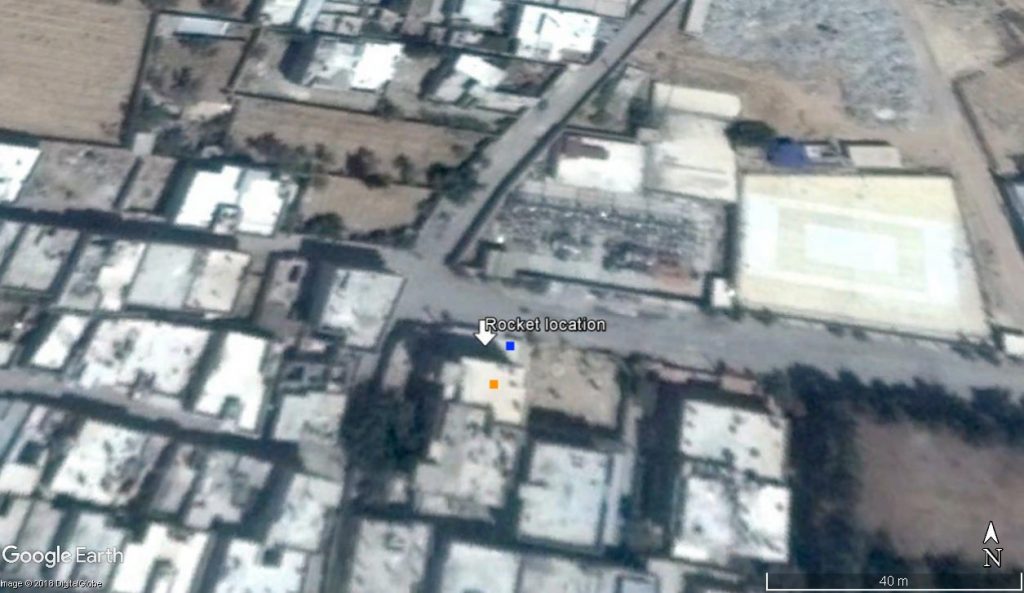
Here I’ve denoted what I first saw and what I believe Eliot was trying to suggest. The orange square is on the building that looks taller than the building with the blue square.
There were two images shot of the cylinder on this rooftop and one of them shows, what looks like, an adjoining building with a conspicuous looking man sitting on rubble in the corner. If you look above his head you will see daylight through a blown-out window thus suggesting that part of the building isn’t very wide. Here are side-by-side shots. The left is the original and the right has its brightness and contrast increased to get a better perception of what’s going on.

Review
Does all that mean that a chlorine attack didn’t happen? Of course not. It just shows that Eliot’s geolocation may not be correct. That the rebel fighter was equally as wrong when he spoke of “a Katyusha rocket” and that each of the sources on alleged victim counts all have their own figures to offer up. If this fighter is right about a “Katyusha rocket” landing on a house then nobody has made an attempt to offer any evidence to support his claim. So far the prosecution’s case looks very weak yet this alleged attack could have had some very profound international consequences.
The day after the alleged attack, then US Secretary of State, Rex Tillerson said:
Only yesterday more than 20 civilians, mostly children, were victims of an apparent chlorine gas attack,
He went on to add:
The recent attacks in Eastern Ghouta raise serious concerns that Bashar al-Assad may be continuing to use chemical weapons against his own people.
Indeed Eliot himself devoted three separate articles to these allegations. The 22 January incident also made quite a stir in the MSM so it got plenty of coverage and could have resulted in further strikes against Syria. Given the evidence so far I’m not sure there is anything like proof the attack happened the way it is claimed it did.
The Travelling Cylinder
Now, I will focus on the “Rooftop Cylinder” a little deeper to see what, if any surprises, it has to offer.
I’m sure you will have noticed how the rocket managed to escape almost any damage after falling from the sky and hitting a concrete rooftop? Let’s compare the completeness of this cylinder with the cylinder at Location 1 in the 1 February incident.
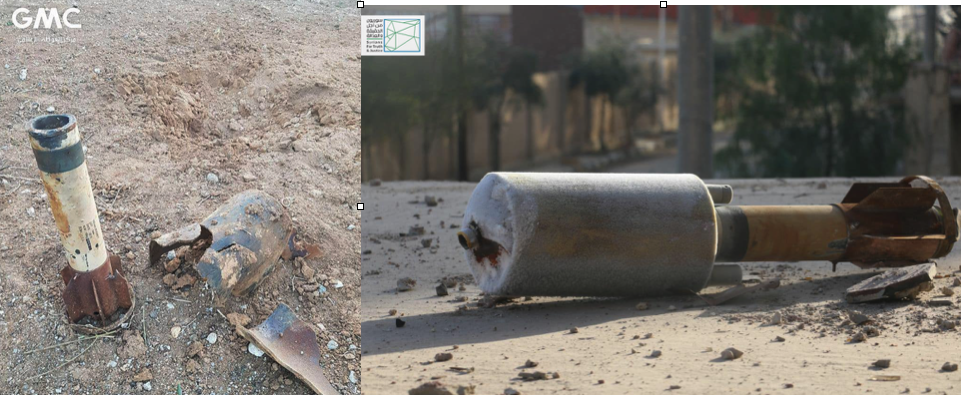
One hits the soil and disintegrates whilst the other hits solid concrete escapes almost undamaged and leaves no impact marks. But what did jump out at me was a rather new looking bolt and screw that secures the tail fin to the rocket motor.
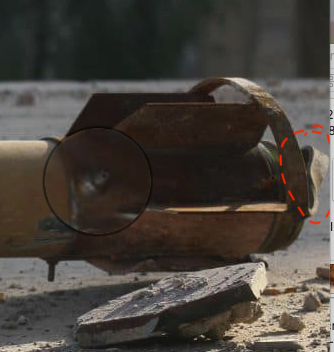
There are three of these bolts in total with the other two as rusty as the rest of the tail fin. Here is a close up of that nut and bolt.
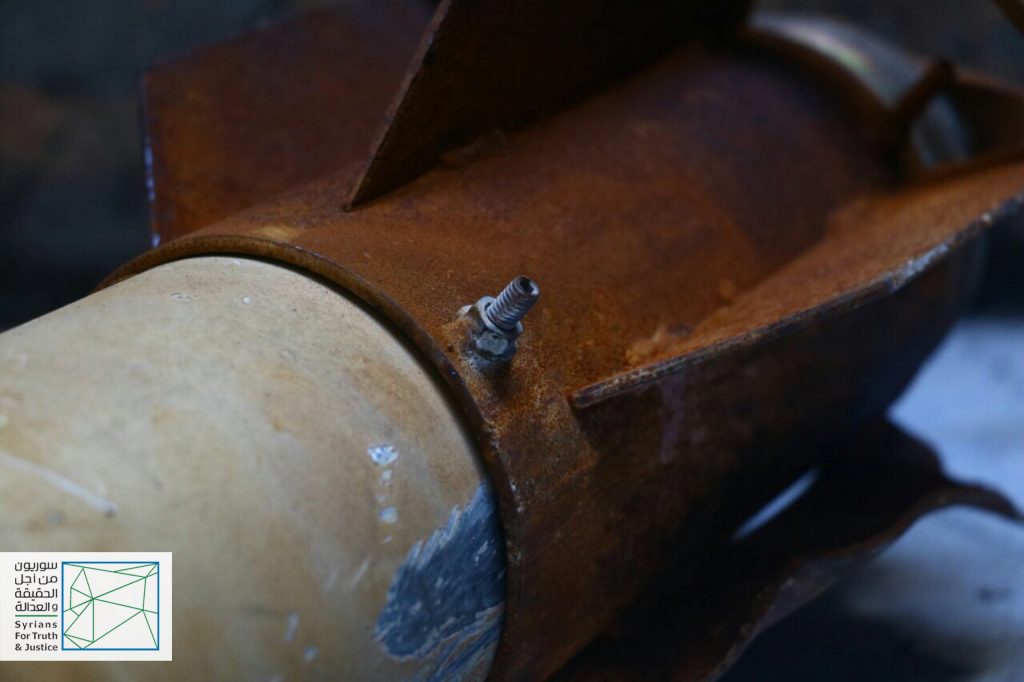
For comparison purposes here is a close up of one of the other nuts and bolts on the same rocket body.
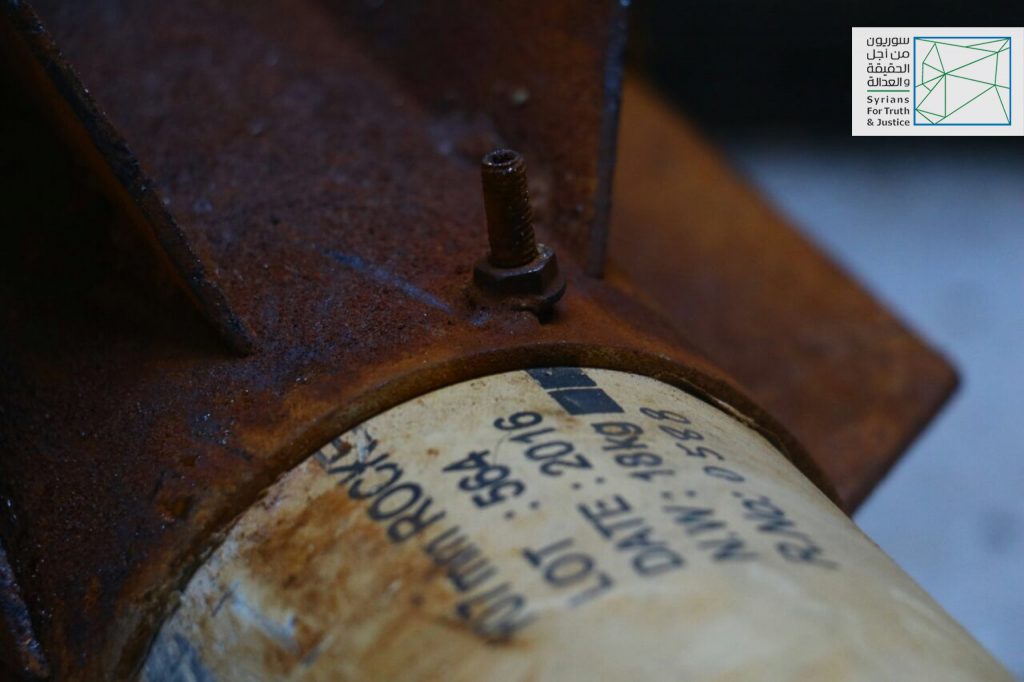
Then my eyes were drawn to the piece of the tail fin that was bent in a fashion that I had seen somewhere before. But where? Having watched hours of video and sifted through hundreds of different images of munitions whilst investigating this case I couldn’t recall where I had seen it but saw it I had. Then it hit me. I had noticed something similar on a tail fin from a Press Conference given by the opposition leaders in East Ghouta. What was throwing me off though was that rocket motor and tail fin were minus their warhead in that conference. I needed to take another look.
Here’s what I found:
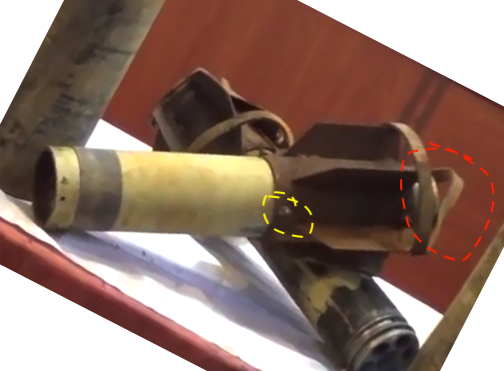
Was this really the same one?

Same newly attached bolt and screw and same 50% deviated tail fin.
In the image of the rocket on the rooftop note the pattern created by the scrapes on the rocket motor paint.
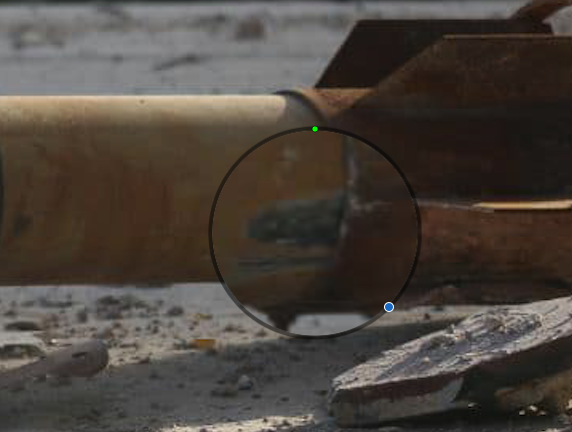
Now back to the rocket motor from the press conference:

For further validation, you will see a bent fin to the left of the scrapes which can be seen in other images of the rocket.
I think you will agree the evidence is pretty clear this rocket motor is the same rocket motor of that from the rooftop munition only someone has given it a good cleaning and it looks like they have removed the date and batch stamp that exists on the IRAMS.
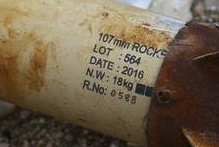
This is what it should show. But to be 100% certain it has been wiped off I’d need to see a full image as there is a small section that points towards the table on both shots.
There’s something missing though, right? The warhead. So I went back and studied the video again and there it was;
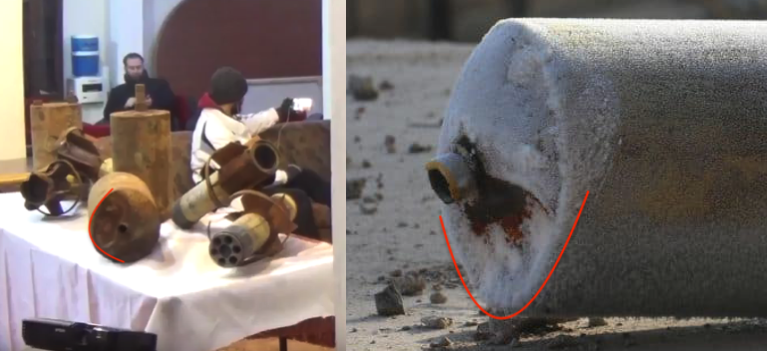
I will draw your attention to a very similar indentation and bent nozzle. I invite you to watch the press conference yourselves and decide whether you agree with me that they are one and the same. I think you will.
The next logical question was how and when did the rocket motor and warhead become separated given they appeared firmly intact less than 24 hours before when they were resting on the rooftop. So, upon closer inspection of the underside of the warhead, I was surprised to see a plate for the rocket motor to slide over.
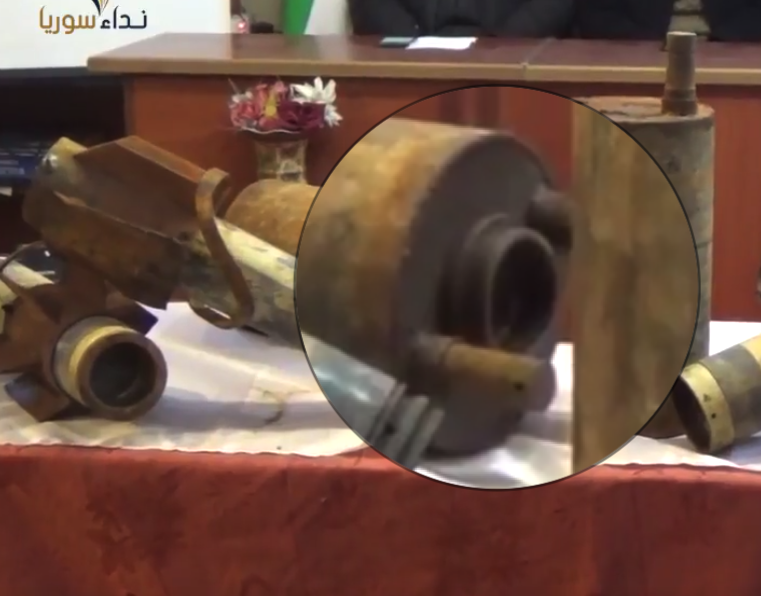
That was a first, for me, seeing a plate on the underside of a cylinder, indeed, there has been much-warranted debate around how the warheads are in fact attached to the rocket motors of the alleged chemical variants. To my knowledge, the only complete example of this munition intact is that cylinder that rested on the rooftop. All other examples always seem to be incomplete.
But I could not see any sign of forced separation either with this plate or the rocket motor. Judge for yourself.
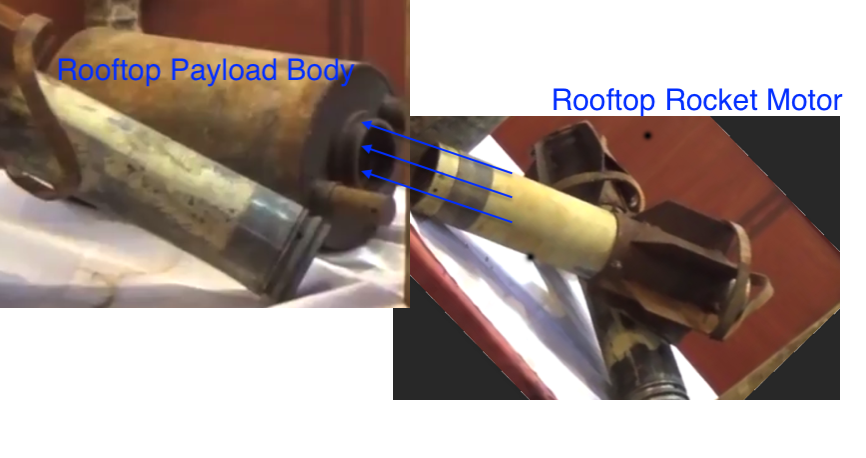
The plate is threaded suggesting that hypothetically, at least, the rocket body is screwed to it.
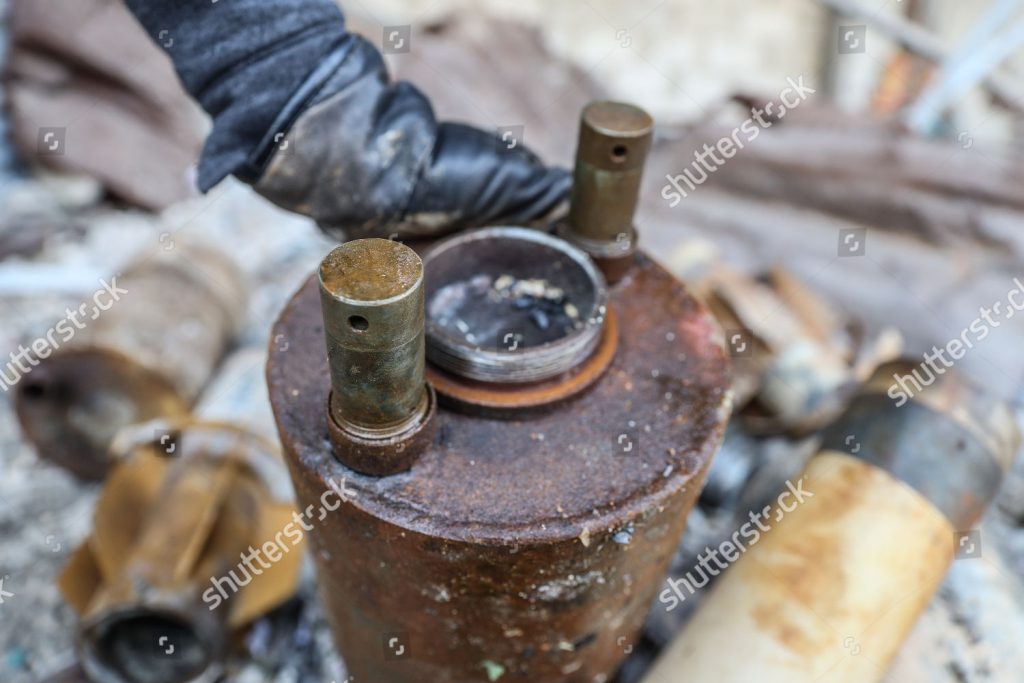
The first thing you will see is the freshly scarred bare metal implying the rocket motor was screwed off and on post “rusting”. How am I sure this is the underside of the 0588 warhead?
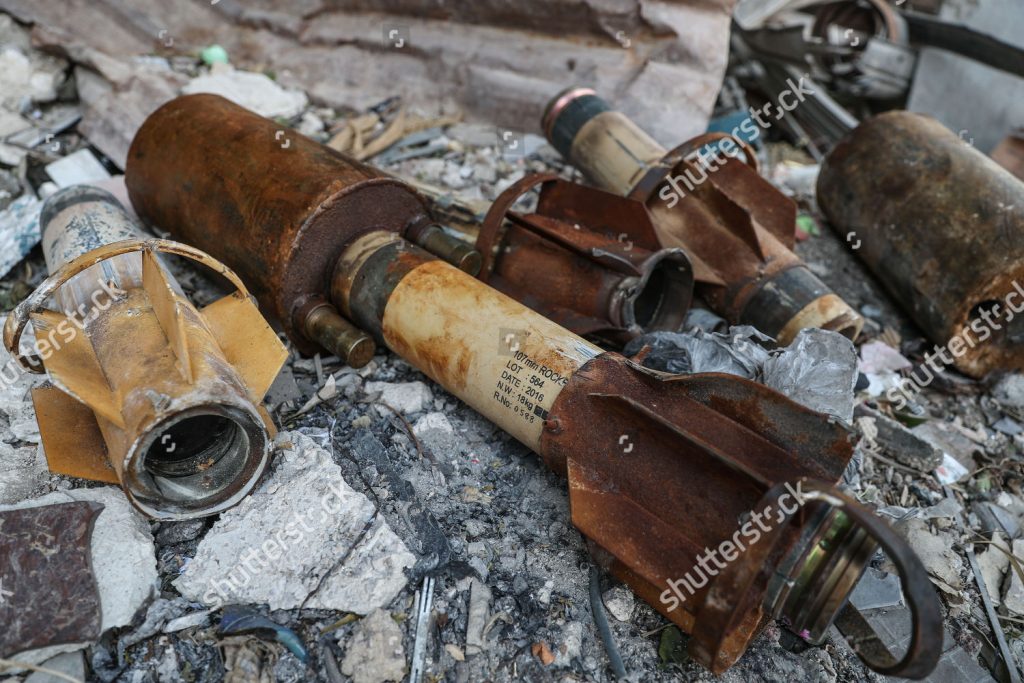
In the next image, I don’t believe this motor to be that of the 0588 rooftop rocket but as I couldn’t find a close up of that I’m using another from the same day that depicts the threaded ending.
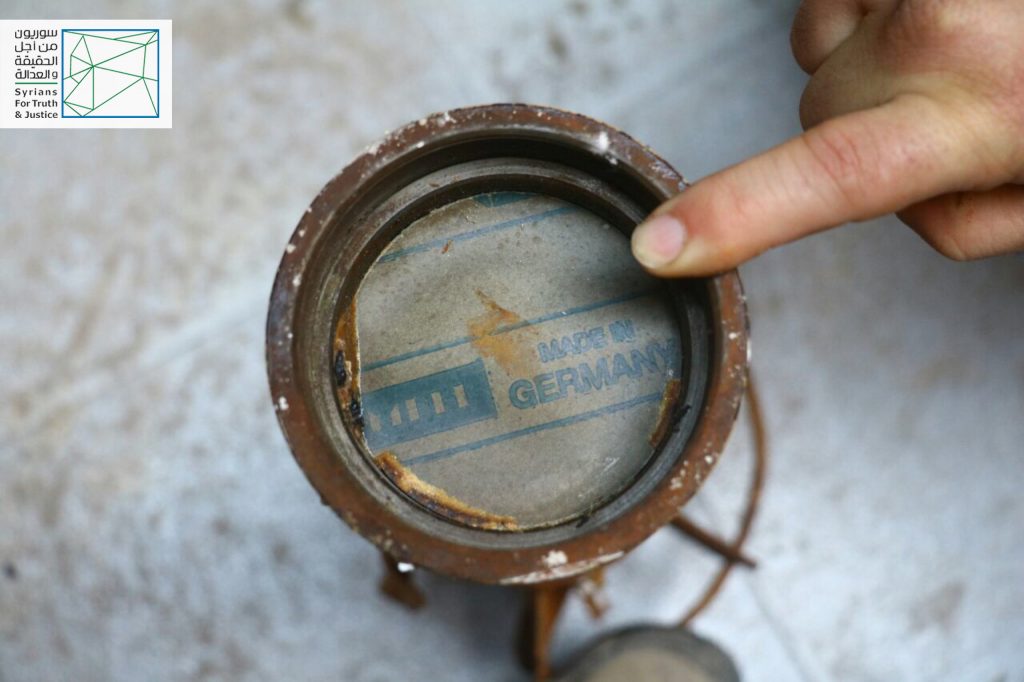
Point of Interest;
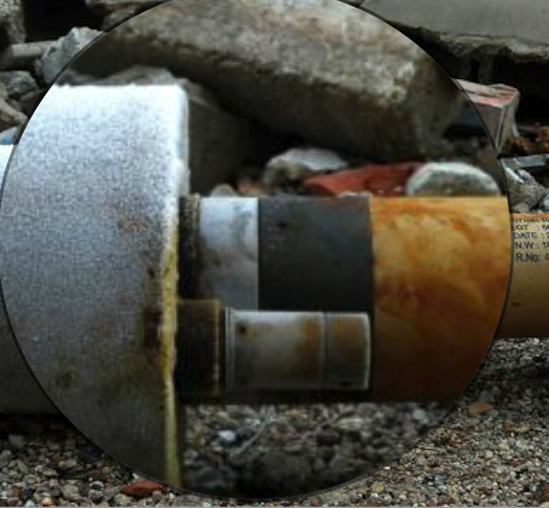
As occurred throughout this study though, I hit a snag.
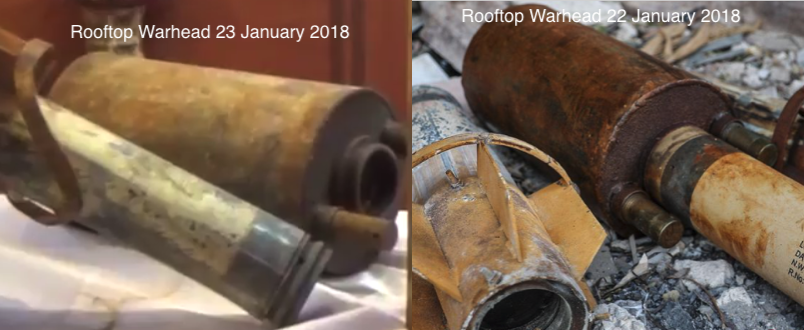
The press conference took place in Douma on the 23 January 2018 whilst the images of the munition (right) were posted online on the 22 January 2018, the day of the alleged attacks. Where had all that rust gone? But that wasn’t all…
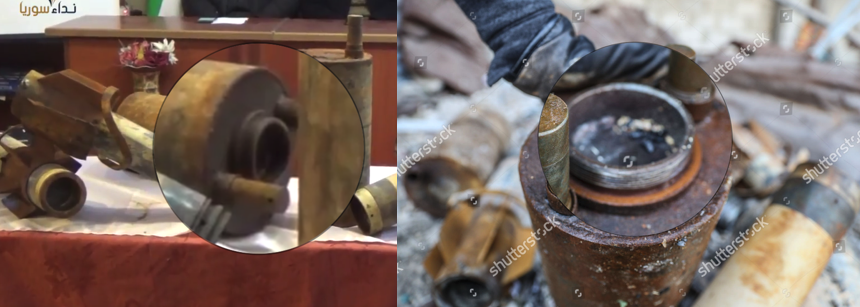
To begin with, the degree of ‘rusting’ on both is very different. If anything you would assume rust gets worse with time rather than better. But what I find even more intriguing is the threaded aft plate. How do the ‘scarred’ threads (right) become agedly rusted (left) within 24 hours? The threaded cylinders equally have a matching rusted tan to match the cylinder head and aft plate. All very strange I thought.
I spent quite a bit of time comparing both cylinder heads and I am 99% certain they are the same. The other 1% would take me to be standing next to them. But if they weren’t? What if the heads were swapped for this photoshoot? For as shown earlier, the cylinder head presented at the press conference is a match for the rooftop cylinder, so if the head used for the shots on the ground is different then the charge stands that the munition was staged. No matter how you look at this incident; no matter what you wish to believe; the evidence is very clear that staging occurred in one or more forms with this cylinder.
If it is the same head being used for all the shots then even more questions present themselves. Is that rust on the right image? Or maybe a lacker that could easily be cleaned off for the presser the following day? Was it during this cleaning process that the batch stamp was accidentally removed from the rocket motor body? Why the need to clean it at all? Was it transferable to skin and clothing maybe? How did the threads become so rusted in the intervening 24 hours? And so on..
What about the frosting? Is there any evidence the frosting may be faked? I believe so. Take a look at the next image.
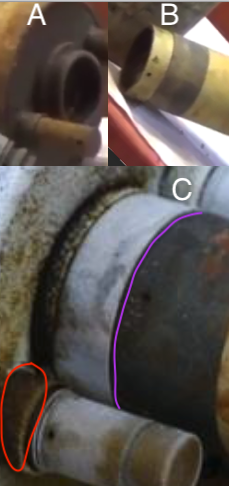
A & B are from the presser and C is from the street. Note the lack of “frost” on the threaded port circled in red compared the opposite side? Also, note how the “frost” formed a perfectly symmetrical line around the top of the rocket motor body denoted by my imperfect purple line? Why would frost stop at black paint and miss a threaded port? Look closer at the “frost” around the top of the rocket motor and notice how smooth and paint like it is compared to the frothy like appearance on the warhead.
We are also told the frost is caused due to the release of a pressurised gas, or adiabatic cooling for the thermodynamic heads amongst you. If that is true then as long as the “frosting” is still occurring the gas is still being released. Think of using a can of compressed air. When the air is released the can becomes cold and frosted. Stop spraying the gas and the can begins to warm to room temperature again. Now given the rooftop cylinder was “frosted” whilst on the roof and, apparently, remained in the same state whilst carried to the street, one must obviously ask who is crazy enough to do such and a thing? And more importantly, why?
Who was crazy enough to carry a chlorine oozing rocket to the ground is easy enough to answer. This guy;
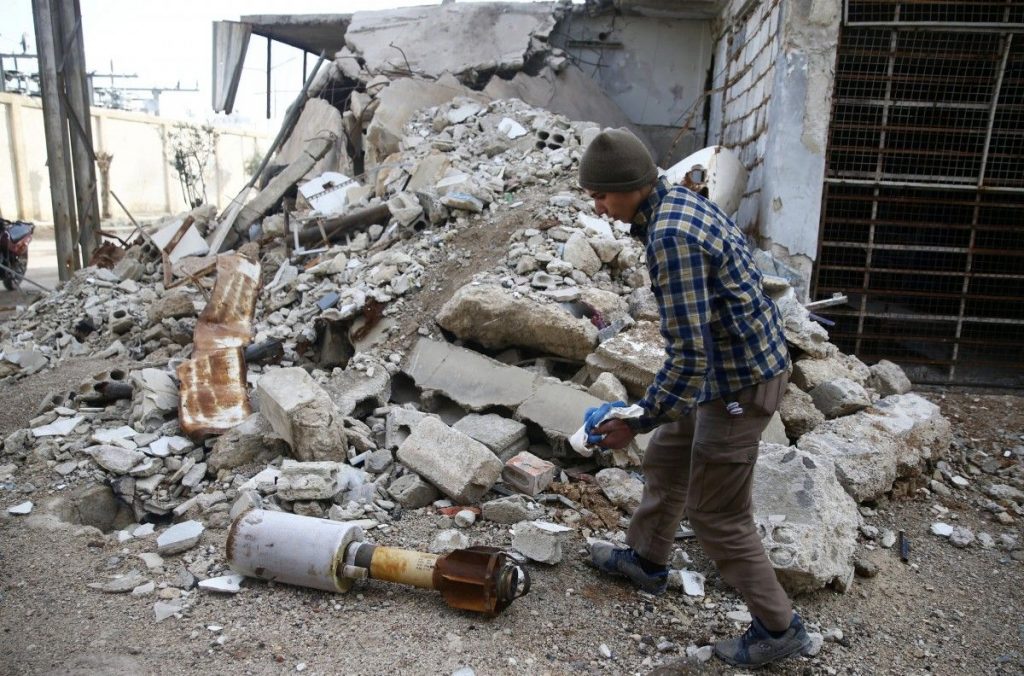
Though I’m not sure how much protection from the deadly gas that rag in his hand will offer him.
Think about that for a second. You have an alleged chemical rocket that is leaking chlorine gas. Why do you pick it up from the crime scene, with a rag cloth mind you, then carry it down to the street for a photoshoot? Does it sound logical?
You may have wondered why I entitled this section “The Travelling Cylinder”? If that isn’t apparent now allow me to present one final trip I have recorded for it. During a March 5, 2018, International Red Cross humanitarian excursion into Douma they also met with some residents to discuss the situation. One of the attendees at this meeting was none other than the “rooftop cylinder”. That thing gets about.

Summary
I focused on two aspects of the allegation of a chlorine gas attack in Douma on the 22 January 2018. Both aspects centred around the defining image of a chlorine cylinder on the rooftop of a building that was later carried down and placed in the street. Photos of which were circulated far and wide via social media and the corporate press.
The first part of my investigation looked at the geolocation carried out by Eliot Higgins on the rooftop cylinder. My conclusion is that Eliot may have gotten this wrong. I showed, in much detail, how I drew that conclusion.
In the second part of the investigation, I looked at the cylinder itself and drew attention to the fact it was being claimed the rocket hit a concrete rooftop, with minimal amount of damage to itself and no apparent damage to the concrete, yet stayed fully intact. I pointed out how, the following day, the rocket was then placed on show at a press conference but in two separate parts whilst not showing any signs of forced separation. I concluded this could only have occurred by manual separation of the rocket motor and warhead and I presented my methodology in reaching that conclusion.
I also looked at the “frosting” on the payload body and questioned whether it looked real or faked. I questioned the possibility of lifting active chlorine releasing rocket with only a cloth in hand for protection.
I appreciate this type of investigation may be too long for some to read and others may lose interest halfway through. Unfortunately being precise often results in lengthy studies as every detail is checked and checked again. I must presume that the reader knows little about the evidence and present it to them in a clear, transparent and precise manner. A manner that doesn’t require them to employ trust in me or my work. A manner that doesn’t require them to employ heavy doses of mental gymnastics in order to see what it is I am trying to prove. Instead, I employ one basic principle that underpins the methodology I use throughout my investigations. I allow the evidence to do the talking.
I do not, however, make any apology for the length of this report as I have invested a considerable amount of time in trying to find the truth. I believe matters of such importance deserve the truth to be found. This alleged incident almost caused an international crisis yet when you take the evidence being offered apart, piece by piece, you begin to see just how weak that evidence is. Whoever is using chemical weapons needs to be found and brought to justice. There can be no apology or hiding place for anyone who does.
The elephant in the room, however, is the idea that radical elements of the opposition have been using them themselves. I often witness those who suggest such a possibility being viciously attacked, slandered, called “war crimes deniers” and “apologists for war criminals”. I find that type of response abhorrent. We all need to keep an open mind when investigating claims of such magnitude. Given some of the actors in Syria one should first ask if a particular claim is possible, even slightly, and if it is, assume it is probable. To ignore the idea that elements of the opposition may be using chemical weapons is to put the rest of the world in danger when these people are eventually forced out off Syria and end up, God knows where. Don’t be afraid to ask difficult questions and don’t be afraid to think outside the box. The staging of chemical attacks is as criminal as actually carrying them out and should be treated just as seriously.
Conclusion
Whether chlorine was used in the alleged attack written about is something I have been unable to find evidence for. I agree with the VDC Doctor Yassin and the SOHR director Rami Rahman, in this instance, and conclude the claim of chlorine used as a weapon cannot be confirmed.
I believe I have uncovered enough evidence to support the idea the narrative surrounding the “Rooftop Cylinder” was false and the scene staged. If I am correct then what has been uncovered is really quite significant and cannot be understated. If this event did not take place as was reported, even going as far as to be addressed by Rex Tillerson, then we must begin to reevaluate all such claims past and present with the utmost vigour, impartiality and hunger for the truth.
I believe that I have shown, at least in the 22/01/18 & 01/02/18 alleged chlorine attacks in Douma, Eliot Higgins has not been interested in investigating the claims but only in confirming them. He has made conspicuous guesstimations on range of rockets with no reason or workings provided. He has ignored, quite willingly, the absence of critical evidence in both instances in his pursuance to make the evidence fit the crimes. I find that quite worrying and troublesome given how trusted he is as a source amongst the corporate media and within western establishment NGO circles.
I would welcome an honest exchange with Eliot on my findings and I would, without hesitation, apologise to him if I have gotten anything wrong. As I said at the outset, this isn’t a blog set up to attack Eliot but he must be confronted when all roads of allegations relating to chlorine in Syria end up at his feet. In circumstances like that, it is difficult not to appear to be singling a person out. This is not personal. This is much bigger than any person. This is about getting to the truth of the allegations of chemical weapons usage.
Upcoming Investigations
My next two investigations are into the 4th February 2018 alleged attack in Saraqib, Idlib and a Part 2a to the above report incorporating all other evidence not mentioned in this report.
Good work
Thanks.
Dr Mohamed Oyoun, cited above, participated in video interview with Syrian Alikhbaria on April 17, 2018 re Douma incident of April 7. See https://www.youtube.com/watch?v=vSrRV-zdNic at about 8:15 together with two other doctors. Dr Nasrullah said “The cases we faced were war injuries. There were no respiratory or allergies symptoms. Honestly I haven’t seen such cases. I even haven’t seen any one have chemo symptoms.” Dr Oyoun said: “These videos were non-qualitative ones. They don’t mean that cases were of chemical effects. They might be cases of bronchitis, asthma or other reasons. To confirm chemical effect, one needs to undergo laboratory tests and further measures, which were unavailable.”
The word “suffocation” does not entail a CHEMICAL attack. The heavy bombing resulted in fires (smoke inhalation) and dust storms, symptoms of which are described in translations of contemporary social media as “suffocation”.